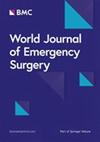不同体位腹内压测量的变化和准确性:一项前瞻性研究
IF 5.8
1区 医学
Q1 EMERGENCY MEDICINE
引用次数: 0
摘要
最近的研究证实,腹内高压(IAH)经常发生在危重患者中,造成器官衰竭和死亡率增加的重大风险。准确测量腹内压(IAP)对于有效诊断、预防和治疗至关重要。以往的研究表明,使用传统Foley导尿管准确测量IAP需要在夹紧导尿管后向膀胱内填充最多25 mL的无菌生理盐水,由于膀胱填充量的变化,限制了持续监测IAP的能力。该导管可以不考虑膀胱填充量而连续测量IAP。主要目的是验证一种新型连续膀胱压力监测装置——创伤导尿管(Sentinel Medical Technologies, Jacksonville, Florida, USA)。对不同体位的ICU患者进行研究,通过比较使用创伤导管和FoleyManometer测量方法(SecurMeter, Deltamed, Viadana,意大利)获得的IAP读数之间的相关性、偏倚、精度和一致性来评估测量准确性。FoleyManometer测量方法作为金标准。本研究的次要终点是探讨不同体位对IAP的影响。纳入需要膀胱导尿的ICU成人患者(≥18岁)。使用创伤导管(IAPTG)和FoleyManometer方法(IAPFM)跨多个体位测量IAP,以获得广泛的IAP值,并研究体位对IAP测量的影响。采用相关性、一致性和Bland-Altman分析,对仰卧位、反向Trendelenburg位(15°、30°和45°)和床头(HOB)仰卧位(15°、30°和45°)的IAPTG和IAPFM进行两两分析。误差网格分析评估了与每个体位测量不准确相关的风险。采用受试者工作特征(ROC)曲线对创伤导管作为IAH检测系统的鲁棒性进行评价。研究了IAP随体位的变化,并与文献综述进行了比较。还记录了每个参与者的性别、年龄、体重指数(BMI)和序贯器官衰竭评估(SOFA)评分。纳入25例成人ICU患者,平均年龄63.6±11.6岁,BMI 28.3±3.7 kg/m2。平均IAP从仰卧位9.8±1.7 mmHg增加到逆Trendelenburg位10.4±1.5 mmHg, HOB抬高位14.9±1.6 mmHg。仰卧位、逆Trendelenburg位和HOB抬高位的相关系数分别为0.9、0.9和0.8。根据Bland-Altman分析,仰卧位显示出0.8和1.7 mmHg的偏差和精度。反向Trendelenburg和HOB海拔位置的偏差分别为- 0.3和1.5 mmHg,精度分别为1.5和1.6 mmHg。对于仰卧位、反向Trendelenburg位和HOB仰卧位,一致性的下限和上限分别为−2.5-4.2 mmHg、−3.2-2.6 mmHg和−1.6-4.6 mmHg,百分比误差分别为35%、28%和21%。与仰卧位(95.3%)和HOB抬高位(92.1%)相比,反向Trendelenburg位的一致性系数最高(100.0%)。误差网格分析显示,仰卧位和反向Trendelenburg位没有中等/高风险误差,HOB仰卧位有2.7%的中等/高风险误差。与金标准相比,在ICU患者中验证一种新的连续IAP监测装置的结果显示出优异的效果。将身体姿势从仰卧改变为反转Trendelenburg或HOB抬高会增加IAP。本文章由计算机程序翻译,如有差异,请以英文原文为准。
Variation and accuracy of intra-abdominal pressure measurement in different body positions: a prospective study
Recent studies confirm that intra-abdominal hypertension (IAH) frequently develops in critically ill patients, posing a significant risk of organ failure and increased mortality. Accurate intra-abdominal pressure (IAP) measurement is essential for effective diagnosis, prevention, and treatment. Previous studies indicate that accurate IAP measurement using traditional Foley catheters requires the bladder to be filled with a maximum of 25 mL of sterile saline solution after clamping the catheter, restricting the ability to monitor IAP continuously due to variations in the bladder fill volume. The TraumaGuard catheter enables continuous IAP measurement irrespective of bladder fill volume. The primary objective was the validation of the TraumaGuard catheter (Sentinel Medical Technologies, Jacksonville, Florida, USA), a new continuous bladder pressure monitoring device. ICU patients were studied across different body positions to assess measurement accuracy by comparing the correlation, bias, precision, and agreement between IAP readings obtained using the TraumaGuard catheter and the FoleyManometer measurement method (SecurMeter, Deltamed, Viadana, Italy), which serves as the gold standard. The secondary endpoint of this study was to investigate the impact of different body positions on IAP. Adult ICU patients (≥ 18 years) requiring bladder catheterisation were enrolled. IAP was measured using a TraumaGuard catheter (IAPTG) and FoleyManometer method (IAPFM) across multiple positions to have a broad range of IAP values and to study the impact of body position on IAP measurement. Pairwise analysis of IAPTG and IAPFM in the supine, reverse Trendelenburg (15°, 30°, and 45°), and head-of-bed (HOB) elevation positions (15°, 30°, and 45°) was performed using correlation, concordance, and Bland-Altman analyses. The error-grid analysis assessed the risk associated with inaccurate measurements at each body position. The robustness of the TraumaGuard catheter as a detection system for IAH detection system was evaluated by receiver operating characteristic (ROC) curve. The IAP variation as a function of body position was investigated and compared with the reviewed literature. Gender, age, body mass index (BMI), and sequential organ failure assessment (SOFA) score were also recorded for each participant. Twenty-five adult ICU patients with a mean age of 63.6 ± 11.6 years and BMI of 28.3 ± 3.7 kg/m2 were included. The mean IAP increased from 9.8 ± 1.7 mmHg in supine to 10.4 ± 1.5 mmHg in reverse Trendelenburg and 14.9 ± 1.6 mmHg in HOB elevation positions. The correlation coefficients were 0.9, 0.9, and 0.8 for supine, reverse Trendelenburg, and HOB elevation positions. The supine positions showed a bias and precision of 0.8 and 1.7 mmHg according to Bland-Altman analysis. Reverse Trendelenburg and HOB elevation positions showed a bias of − 0.3 and 1.5 mmHg with a precision of 1.5 and 1.6 mmHg, respectively. The lower and upper limits of agreement were − 2.5–4.2 mmHg, − 3.2–2.6 mmHg, and − 1.6–4.6 mmHg for supine, reverse Trendelenburg, and HOB elevation positions with a percentage error of 35%, 28%, and 21%, respectively. Concordance coefficients were highest in reverse Trendelenburg positions (100.0%) compared to supine (95.3%) and HOB elevation (92.1%) positions. The error-grid analysis indicated no medium/high-risk errors for supine and reverse Trendelenburg and a 2.7% medium-risk error at HOB elevation positions. The results of this validation of a new continuous IAP monitoring device in ICU patients showed excellent results when compared to the gold standard. Changing the body position from supine to reverse Trendelenburg or HOB elevation increases the IAP.
求助全文
通过发布文献求助,成功后即可免费获取论文全文。
去求助
来源期刊

World Journal of Emergency Surgery
EMERGENCY MEDICINE-SURGERY
CiteScore
14.50
自引率
5.00%
发文量
60
审稿时长
10 weeks
期刊介绍:
The World Journal of Emergency Surgery is an open access, peer-reviewed journal covering all facets of clinical and basic research in traumatic and non-traumatic emergency surgery and related fields. Topics include emergency surgery, acute care surgery, trauma surgery, intensive care, trauma management, and resuscitation, among others.
 求助内容:
求助内容: 应助结果提醒方式:
应助结果提醒方式:


